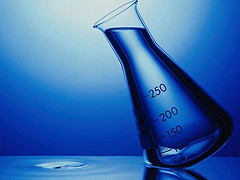
| HOME |
| SYLLABUS |
| EXPERIMENTS |
| REPORTS |
| HOMEWORK |
| EXAMS |
| HANDOUTS |
| EQUIPMENT |
| LAB RULES AND SAFETY |
| UMSL DEPT OF CHEMISTRY |
WELCOME |
Prerequisites: CHEM 3333, CHEM 4412 and CHEM 3643, (CHEM 3643 may be taken concurrently). The more sophisticated techniques of physical and analytical chemistry will be used to study inorganic compounds and their reactions. One hour of lecture and four and one-half hours of laboratory per week. Not for graduate credit. CHEM 4433 is a two credit hour lecture/laboratory course. See: http://www.umsl.edu/bulletin/as/chemistry.html . This is an advanced laboratory course. It is assumed that you have previously and satisfactorily mastered concepts, techniques, and applications in prior coursework (e.g. CHEM 2612, 2622, 3412, 4412) concerning NMR, Infrared, UV-vis spectroscopy, organic synthesis and mechanisms, and inorganic chemistry theory and applications. CHEM 4433 is a two credit hour writing intensive laboratory course that introduces the student to inorganic synthetic techniques, magnetism, and structural determination techniques and methods. In this course you will (1) review and apply inorganic chemistry principles and physical characterization techniques, (2) perform laboratory experiments, and (3) write and complete formal J. Am. Chem. Soc.-style reports (in manuscript format). As a general rule, at least 6 hours per week should be devoted to studying concepts introduced in class and the textbook; homework problem sets are considered in addition to this suggestion and will generally take 2-4 hours if these concepts are understood. Working in groups and scheduling office hours may also aid students in these efforts. Report writing times will depend on the individual but expect to take at least 5-6 hours for the construction of each report. If work, other courses, and/or other responsibilities will not allow for these time investments, please see the instructor as soon as possibleto discuss possible options. The reports will demonstrate your understanding of basic laboratory synthesis, spectroscopy, data interpretation, and inorganic chemistry. The most important outcomes of your efforts are to know the basics of inorganic chemistry, think critically about a particular reaction pathway or set of data, and predict/propose likely outcomes and/or reasons for the observed behavior.
|